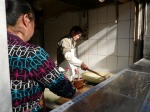Trip to China, day 3 (04.09.2014)
In the morning we made our way to the National Museum which was quite big and new and also had interesting exhibitions such as modern-day chinese ceramics and diplomatic presents from many countries. The museum has recently been redesigned by a German architecture bureau. Furthermore there were galleries with pictures from wartime – the communist army and their officials were shown in many places, including many pictures from comrade Mao Zedong. In the main hall there are famous paintings with revolutionary-communist themes. After some time we became very hungry. Even though it was raining quite heavily since we got up in the morning, we left the museum to look for a restaurant.
The problem was that on and around Tiananmen, there were still rigorous crowd control mesures in place after the celebrations of 70 years End of WW II. We were forced to follow the stream of people between two fences into a public garden east of the Forbidden City and there was no way out but the West gate leading into the first inner courtyard of the latter. We actually just wanted to traverse Tiananment in order to get to its west end. It turned out that we had to senselessly walk around in the heavy rain for about an hour. There was no way over or past the fence – security personnel from police and army forces controled every move of the crowd which was, like flocks of sheep, trying to play along with the circus. After some time we were soaking wet to the underpants, hungry and had wasted a lot of time. In the end we found a restaurant selling jiao zi of average quality at ten kuai (Ten yuan ren min bi, about 1,4 Euros) for one serving. We ate and it made us a bit happier because we were so hungry that pretty much anything would have been fine to eat at this point. At a convenience store be got some water and Schweppes +C Lemon soft drink.
After our late lunchbreak (it was about 3 pm already) we still tried to get to the Great Hall of the People which is said to be interesting to see, but crowd control measure had us walk in circles around it and we became even more wet – including the contents of our bags as we found out later. We wasted a lot of time and the rain became so heavy that it was monsoon-like and even the Chinese literally fled the open space on Tiananmen. Along with the crowd we tried to protect ourselves against the rainstorm in the entrance area of a big public toilet. As the worst was over after some minutes, we tried to get back to our Hutong/Hostel which took us quite long. Back there we took a hot shower. At the reception we asked for a place where we could hang our clothes to dry and he suggested that theres a clothesline in the courtyard – we were a bit puzzled because it was still raining heavily. Staff at the reception of Ming Courtyard Hostel was friendly but they did not understand enough English to answer questions which were more complicated than: “Where is the train station?” and “Where are the lockers?”
In the evening we only ate some Mannerschnitten because we did not want to go outside anymore – our raincoats did not withstand the amount of water that poured down on us during the day. We had a chat with our American roommates Sydney and Boston which was quite nice, and then went to sleep rather early.
























